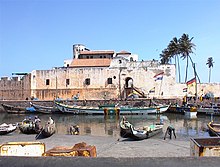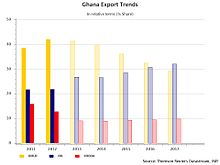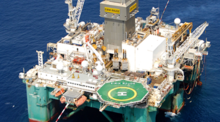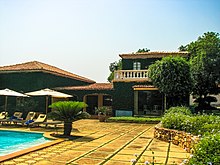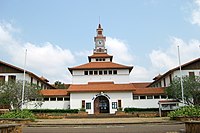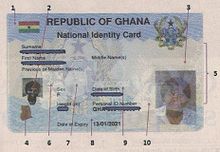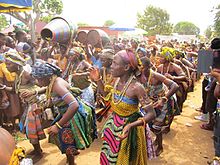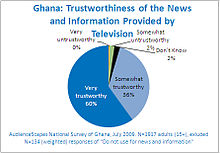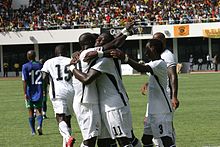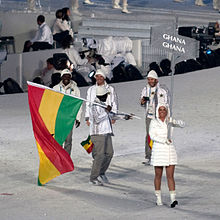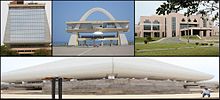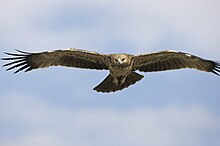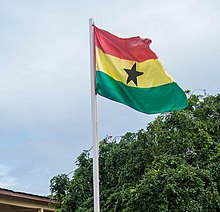Ghana
Jump to navigationJump to search
|
Republic of Ghana
|
|
|---|---|
|
Motto: “Freedom and Justice”
|
|
|
Anthem: “God Bless Our Homeland Ghana” |
|
 |
|
| Capital
and largest city
|
Accra 5°33′N 0°12′W |
| Official languages | English[1][2] |
| Recognised national languages | |
| Ethnic groups |
|
| Demonym(s) | Ghanaian |
| Government | |
| Nana Akufo-Addo | |
| Mahamudu Bawumia | |
| Legislature | Parliament |
| Independence from the United Kingdom | |
|
• Dominion
|
6 March 1957 |
|
• Republic
|
1 July 1960 |
| 28 April 1992 | |
| Area | |
|
• Total
|
239,567 km2 (92,497 sq mi) (80th) |
|
• Water (%)
|
4.61 (11,000 km; 4,247 mi2) |
| Population | |
|
• 2016 estimate
|
28,308,301[4] (45th) |
|
• 2010 census
|
24,200,000[5] |
|
• Density
|
101.5/km2 (262.9/sq mi) (103rd) |
| GDP (PPP) | 2020 estimate |
|
• Total
|
$226 billion[6] |
|
• Per capita
|
$7,343[6] |
| GDP (nominal) | 2020 estimate |
|
• Total
|
$69.757 billion[6] |
|
• Per capita
|
$2,266[6] |
| Gini (2012) | 42.4[7] medium |
| HDI (2018) | medium · 142nd |
| Currency | Ghanaian cedi (GHS) |
| Time zone | UTC (GMT) |
| Driving side | right |
| Calling code | +233 |
| ISO 3166 code | GH |
| Internet TLD | .gh |
Ghana (/ˈɡɑːnə/ (![]() listen)), officially the Republic of Ghana, is a country located along the Gulf of Guinea and Atlantic Ocean, in the subregion of West Africa. Spanning a land mass of 238,535 km2 (92,099 sq mi), Ghana is bordered by the Ivory Coast in the west, Burkina Faso in the north, Togo in the east, and the Gulf of Guinea and Atlantic Ocean in the south. Ghana means “Warrior King” in the Soninke language.[9]
listen)), officially the Republic of Ghana, is a country located along the Gulf of Guinea and Atlantic Ocean, in the subregion of West Africa. Spanning a land mass of 238,535 km2 (92,099 sq mi), Ghana is bordered by the Ivory Coast in the west, Burkina Faso in the north, Togo in the east, and the Gulf of Guinea and Atlantic Ocean in the south. Ghana means “Warrior King” in the Soninke language.[9]
The first permanent state in the territory of present-day Ghana dates back to the 11th century. Numerous kingdoms and empires emerged over the centuries, of which the most powerful was the Kingdom of Ashanti.[10] Beginning in the 15th century, the Portuguese Empire, followed by numerous other European powers, contested the area for trading rights, until the British ultimately established control of the coast by the late 19th century. Following over a century of native resistance, Ghana’s current borders were established by the 1900s as the British Gold Coast. It became independent of the United Kingdom on 6 March 1957.[11][12][13]
Ghana’s population of approximately 30 million[14] spans a variety of ethnic, linguistic and religious groups.[4] According to the 2010 census, 71.2% of the population was Christian, 17.6% was Muslim, and 5.2% practised traditional faiths.[15] Its diverse geography and ecology ranges from coastal savannahs to tropical rain forests.
Ghana is a unitary constitutional democracy led by a president who is both head of state and head of the government.[16] Ghana’s growing economic prosperity and democratic political system have made it a regional power in West Africa.[17] It is a member of the Non-Aligned Movement, the African Union, the Economic Community of West African States (ECOWAS), Group of 24 (G24) and the Commonwealth of Nations.[18]
Etymology[edit]
The etymology of the word Ghana means “warrior king” and was the title accorded to the kings of the medieval Ghana Empire in West Africa, but the empire was further north than the modern country of Ghana, in the region of Guinea.[19]
History[edit]
16th-century Akan Terracotta, Metropolitan Museum of Art
An 1850 map showing the Akan Kingdom of Ashanti within the Guinea region and surrounding regions in West Africa
Medieval kingdoms[edit]
Ghana was already recognized as one of the great kingdoms in Bilad el-Sudan by the ninth century.[20]
Ghana was inhabited in the Middle Ages and the Age of Discovery by a number of ancient predominantly Akan kingdoms in the Southern and Central territories. This included the Ashanti Empire, the Akwamu, the Bonoman, the Denkyira, and the Mankessim Kingdom.[21]
Although the area of present-day Ghana in West Africa has experienced many population movements, the Akans were firmly settled by the 5th century CE.[22][23] By the early 11th century, the Akans were firmly established in the Akan state called Bonoman, for which the Brong-Ahafo Region is named.[22][24]
From the 13th century, Akans emerged from what is believed to have been the Bonoman area, to create several Akan states of Ghana, mainly based on gold trading.[25] These states included Bonoman (Brong-Ahafo Region), Ashanti (Ashanti Region), Denkyira (Western North region), Mankessim Kingdom (Central region), and Akwamu (Eastern region).[22] By the 19th century, the territory of the southern part of Ghana was included in the Kingdom of Ashanti, one of the most influential states in sub-saharan Africa prior to the onset of colonialism.[22]
The Kingdom of Ashanti government operated first as a loose network, and eventually as a centralised kingdom with an advanced, highly specialised bureaucracy centred in the capital city of Kumasi.[22] Prior to Akan contact with Europeans, the Akan people created an advanced economy based on principally gold and gold bar commodities then traded with the states of Africa.[22][26]
The earliest known kingdoms to emerge in modern Ghana were the Mole-Dagbani states.[22] The Mole-Dagomba came on horseback from present-day Burkina Faso under a single leader, Naa Gbewaa.[27] With their advanced weapons and based on a central authority, they easily invaded and occupied the lands of the local people ruled by the Tendamba (land god priests), established themselves as the rulers over the locals, and made Gambaga their capital.[28] The death of Naa Gbewaa caused civil war among his children, some of whom broke off and founded separate states including Dagbon, Mamprugu, Mossi, Nanumba and Wala.[29][30]
European contact (15th century)[edit]
The Portuguese established the Portuguese Gold Coast with the construction of Elmina Castle (Castelo da Mina) by Diogo de Azambuja in 1482, making it the oldest European building in Sub-Saharan Africa.
Akan trade with European states began after contact with the Portuguese in the 15th century.[31] Early European contact by the Portuguese people, who came to the Gold Coast region in the 15th century to trade and then established the Portuguese Gold Coast (Costa do Ouro), focused on the extensive availability of gold.[32] The Portuguese built a trading lodge at a coastal settlement called Anomansah (the perpetual drink) which they renamed São Jorge da Mina.[32]
In 1481, King John II of Portugal commissioned Don Diego d’Azambuja to build the Elmina Castle, which was completed in three years.[32] By 1598, the Dutch had joined the Portuguese in the gold trade, establishing the Dutch Gold Coast (Nederlandse Bezittingen ter Kuste van Guinea) and building forts at Fort Komenda and Kormantsi.[33] In 1617, the Dutch captured the Olnini Castle from the Portuguese, and Axim in 1642 (Fort St Anthony).[33]
Other European traders had joined in gold trading by the mid-17th century, most notably the Swedes, establishing the Swedish Gold Coast (Svenska Guldkusten), and Denmark-Norway, establishing the Danish Gold Coast (Danske Guldkyst or Dansk Guinea).[34] Portuguese merchants, impressed with the gold resources in the area, named it Costa do Ouro or Gold Coast.[34] Also beginning in the 17th century — in addition to the gold trade — Portuguese, Dutch, English, and French traders also participated in the Atlantic slave trade in this area.[35]
The first Anglo-Ashanti war, 1823–31
More than thirty forts and castles were built by the Portuguese, Swedish, Dano-Norwegians, Dutch and German merchants; the latter Germans establishing the German Gold Coast (Brandenburger Gold Coast or Groß Friedrichsburg).[36] In 1874 Great Britain established control over some parts of the country, assigning these areas the status of British Gold Coast.[37] Many military engagements occurred between the British colonial powers and the various Akan nation-states. The Akan Kingdom of Ashanti defeated the British a few times in the 100-year-long Anglo-Ashanti wars but eventually lost with the War of the Golden Stool in the early 1900s.[38][39][40]
Transition to independence[edit]
Kwame Nkrumah, first President of Ghana
In 1947, the newly formed United Gold Coast Convention (UGCC) led by “The Big Six” called for “self-government within the shortest possible time” following the Gold Coast legislative election, 1946.[34][41] Kwame Nkrumah was the first Prime Minister of Ghana and the first President of Ghana and formed the Convention People’s Party (CPP) with the motto “self-government now”.[34]
Nkrumah won a majority in the Gold Coast legislative election, 1951 for the Gold Coast Legislative Assembly in 1952. Nkrumah was appointed leader of the Gold Coast’s government business.[34] The Gold Coast region declared independence from the United Kingdom on 6 March 1957 and established the nation of Ghana.[11][12][13]
On 6 March 1957 at 12 am. Nkrumah declared Ghana’s establishment and autonomy. On 1 July 1960, following the Ghanaian constitutional referendum and Ghanaian presidential election, Nkrumah declared Ghana as a republic as the first President of Ghana.[34] 6 March is the nation’s Independence Day and 1 July is now celebrated as Republic Day.[42][43]
At the time of independence Nkrumah declared, “My first objective is to abolish from Ghana poverty, ignorance, and disease. We shall measure our progress by the improvement in the health of our people; by the number of children in school, and by the quality of their education; by the availability of water and electricity in our towns and villages; and by the happiness which our people take in being able to manage their own affairs. The welfare of our people is our chief pride, and it is by this that the government will ask to be judged.”.[44]
The flag of Ghana, consisting of the colours red, gold, green, and a black star, became the new flag in 1957 when Gold Coast gained its name Ghana.[45] It was designed by Theodosia Salome Okoh; the red represents the blood that was shed towards independence, the gold represents the industrial minerals wealth of Ghana, the green symbolises the rich grasslands of Ghana, and the black star is the symbol of the Ghanaian people and African emancipation.[46]
Nkrumah was the first African head of state to promote the concept of Pan-Africanism, which he had been introduced to during his studies at Lincoln University, Pennsylvania in the United States, at the time when Marcus Garvey was becoming famous for his “Back to Africa Movement”.[34] Nkrumah merged the teachings of Marcus Garvey, Martin Luther King, Jr. and the naturalised Ghanaian scholar W. E. B. Du Bois into the formation of 1960s Ghana.[34]
Osagyefo Dr. Kwame Nkrumah, as he became known, played an instrumental part in the founding of the Non-Aligned Movement, and in establishing the Kwame Nkrumah Ideological Institute to teach his ideologies of communism and socialism.[47] His life achievements were recognised by Ghanaians during his centenary birthday celebration, and the day was instituted as a public holiday in Ghana (Founder’s Day).[48]
Operation Cold Chop and aftermath[edit]
The government of Nkrumah was subsequently overthrown by a coup by the Ghana Armed Forces codenamed “Operation Cold Chop”. This occurred while Nkrumah was abroad with Zhou Enlai in the People’s Republic of China, on a fruitless mission to Hanoi in Vietnam to help end the Vietnam War. The coup took place on 24 February 1966, led by Col. Emmanuel Kwasi Kotoka. The National Liberation Council (NLC) was formed, chaired by Lt. General Joseph A. Ankrah.[49]
A series of alternating military and civilian governments, often affected by economic instabilities,[50] ruled Ghana from 1966 to 1981, ending with the ascension to power of Flight Lieutenant Jerry John Rawlings of the Provisional National Defence Council (PNDC) in 1981.[51] These changes resulted in the suspension of the Constitution of Ghana in 1981, and the banning of political parties in Ghana.[52] The economy soon declined, so Rawlings negotiated a structural adjustment plan changing many old economic policies, and economic growth soon recovered during the mid-1980s.[52] A new Constitution of Ghana restoring multi-party system politics was promulgated in Ghanaian presidential election, 1992; Rawlings was elected as president of Ghana then, and again in Ghanaian general election, 1996.[53]
21st century[edit]
Traditional chiefs in Ghana in 2015
Winning the 2000 Ghanaian elections, John Agyekum Kufuor of the New Patriotic Party (NPP) was sworn into office as president of Ghana on 7 January 2001, and attained the presidency again in the 2004 Ghanaian elections, thus also serving two terms (the term limit) as president of Ghana and thus marking the first time under the fourth republic that power was transferred from one legitimately elected head of state and head of government to another.[53]
Nana Akufo-Addo, the ruling party candidate, was defeated in a very close election by John Atta Mills of the National Democratic Congress (NDC) following the Ghanaian presidential election, 2008.[54][55]. Mills died of natural causes and was succeeded by vice-president John Dramani Mahama on 24 July 2012.[56]
Following the Ghanaian presidential election, 2012, John Dramani Mahama became President-elect and was inaugurated on 7 January 2013.[57] Ghana was a stable democracy.[53]
As a result of the Ghanaian presidential election, 2016,[58] Nana Akufo-Addo became President-elect and was inaugurated as the fifth President of the Fourth Republic of Ghana and eighth President of Ghana on 7 January 2017.[59]
Historical timeline[edit]

Geography and geology[edit]
Ghana is located on the Gulf of Guinea, only a few degrees north of the Equator, therefore giving it a warm climate.[60] Ghana spans an area of 238,535 km2 (92,099 sq mi), and has an Atlantic coastline that stretches 560 kilometres (350 miles) on the Gulf of Guinea in Atlantic Ocean to its south.[60] It lies between latitudes 4°45’N and 11°N, and longitudes 1°15’E and 3°15’W. The Prime Meridian passes through Ghana, specifically through the industrial port town of Tema.[60] Ghana is geographically closer to the “centre” of the Earth geographical coordinates than any other country; even though the notional centre, (0°, 0°) is located in the Atlantic Ocean approximately 614 km (382 mi) off the south-east coast of Ghana on the Gulf of Guinea. Grasslands mixed with south coastal shrublands and forests dominate Ghana, with forest extending northward from the south-west coast of Ghana on the Gulf of Guinea in the Atlantic Ocean 320 kilometres (200 miles) and eastward for a maximum of about 270 kilometres (170 miles) with the Kingdom of Ashanti or the southern part of Ghana being a primary location for mining of industrial minerals and timber.[60]
Ghana encompasses plains, waterfalls, low hills, rivers, Lake Volta, the world’s largest artificial lake, Dodi Island and Bobowasi Island on the south Atlantic Ocean coast of Ghana.[61] The northernmost part of Ghana is Pulmakong and the southernmost part of Ghana is Cape Three Points.[60]
Climate[edit]
The climate of Ghana is tropical and there are two main seasons: the wet season and the dry season.
| showClimate data for Ghana |
|---|
Government[edit]
Parliament House of Ghana seat of the Government of Ghana, the Supreme Court of Ghana and Judiciary of Ghana buildings, Osu Castle is the de facto residence of presidency and The Flagstaff House is the official residence and presidential palace.
Ghana is a unitary presidential constitutional democracy with a parliamentary multi-party system. Ghana alternated between civilian and military governments until January 1993, when the military government gave way to the Fourth Republic of Ghana after presidential and parliamentary elections in late 1992. The 1992 constitution of Ghana divides powers among a Commander-in-Chief of the Ghana Armed Forces (President of Ghana), parliament (Parliament of Ghana), cabinet (Cabinet of Ghana), council of state (Ghanaian Council of State), and an independent judiciary (Judiciary of Ghana). The Government of Ghana is elected by universal suffrage after every four years.[63]
Nana Akufo-Addo won the Presidency in the Ghanaian general election held on 7 December 2016, defeating incumbent John Mahama. He was sworn in on 7 January 2017.
The 2012 Fragile States Index indicated that Ghana is ranked the 67th least fragile state in the world and the 5th least fragile state in Africa after Mauritius, 2nd Seychelles, 3rd Botswana, and 4th South Africa. Ghana ranked 112th out of 177 countries on the index.[64] Ghana ranked as the 64th least corrupt and politically corrupt country in the world out of all 174 countries ranked and Ghana ranked as the 5th least corrupt and politically corrupt country in Africa out of 53 countries in the 2012 Transparency International Corruption Perception Index.[65][66] Ghana was ranked 7th in Africa out of 53 countries in the 2012 Ibrahim Index of African Governance. The Ibrahim Index is a comprehensive measure of African government, based on a number of different variables which reflect the success with which governments deliver essential political goods to its citizens.[67] Nkrumah was a Ghanaian nationalist leader who led the country from 1957 to 1966. Nkrumah’s political journey started when he entered Lincoln University in Pennsylvania in 1935. He graduated with master’s degrees from Lincoln University and the University of Pennsylvania. He formed the Convention Peoples’ Party. The party initiated a “positive action” campaign involving non-violent protests, strikes and non-cooperation with the British authorities. Nkrumah was arrested and sentenced to one year imprisonment during this time. In the Gold Coast’s February 1951 general election, he was elected to Parliament and released from prison to become leader of government business. He became Prime Minister of the Gold Coast in 1952s leadership was authoritarian but he improved the infrastructure of the country and his Africanisation policies created better career opportunities for Ghanaians. He was deposed in a coup in 1966.
Foreign relations[edit]
Kofi Annan, Ghanaian diplomat and United Nations Secretary-General 1997–2006
Since independence, Ghana has been devoted to ideals of nonalignment and is a founding member of the Non-Aligned Movement. Ghana favours international and regional political and economic co-operation, and is an active member of the United Nations and the African Union.[68]
Ghana has a strong relationship with the United States. Three recent US presidents–Bill Clinton, George W. Bush, and Barack Obama—made diplomatic trips to Ghana. Many Ghanaian diplomats and politicians hold positions in international organisations, including Ghanaian diplomat and former Secretary-General of the United Nations Kofi Annan, International Criminal Court Judge Akua Kuenyehia, and former President Jerry John Rawlings and former President John Agyekum Kuffour, who both served as diplomats of the United Nations.[63]
In September 2010, Ghana’s former President John Atta Mills visited China on an official visit. Mills and China’s former President Hu Jintao, marked the 50th anniversary of diplomatic ties between the two nations, at the Great Hall of the People on 20 September 2010.[69] China reciprocated with an official visit in November 2011, by the Vice-Chairman of the Standing Committee of the National People’s Congress of China, Zhou Tienong who visited Ghana and met with Ghana’s President John Dramani Mahama.[70]
The Islamic Republic of Iran and the 6th President of Iran, Mahmoud Ahmadinejad met with the 12th President of Ghana, John Dramani Mahama on 16 April 2013 to hold discussions with President John Dramani Mahama on strengthening the Non-Aligned Movement and also co–chair a bilateral meeting between Ghana and Iran at the Ghanaian presidential palace Flagstaff House.[71][72][73][74][75] The Government of Ghana reciprocated with an official state visit on 5 August 2013 by the Vice-President of Ghana, Kwesi Amissah-Arthur, who met with the Vice-President of Iran, Eshaq Jahangiri on the basis of autarky and possible bilateral trade at the Islamic Republic of Iran‘s presidential palace, Sa’dabad Palace.[76]
Law enforcement and police[edit]
Militarized police Unit of the Ghana Police Service
The Ghana Police Service (GPS) and the Criminal Investigation Department (CID) are the main law enforcement agencies of the Republic of Ghana, and are responsible for the detection of crime, maintenance of law and order and the maintenance of internal peace and security.[77] The Ghana Police Service has eleven specialised police units including a Militarized police Rapid deployment force (RDF) and Marine Police Unit (MPU).[78][79] The Ghana Police Service operates in 12 divisions: ten covering the ten regions of Ghana, one assigned specifically to the seaport and industrial hub of Tema, and the twelfth being the Railways, Ports and Harbours Division.[79] The Ghana Police Service’s Marine Police Unit and Division handles issues that arise from the country’s offshore oil and gas industry.[79]
The Ghana Prisons Service and the sub-division Borstal Institute for Juveniles administers incarceration in Ghana.[80] Ghana retains and exercises the death penalty for treason, corruption, robbery, piracy, drug trafficking, rape, and homicide.[81][82] 27 convicts (all men) were sentenced to death in Ghana in 2012 and the Ghana Prisons Service statistics of the total number of convicts sentenced to death in Ghana as of December 2012 was 162 men and 4 women,[81] with a total prison inmate population of 13,983 convicts as of 22 July 2013.[83] “The new sustainable development goals adopted by the United Nations call for the international community to come together to promote the rule of law; support equal access to justice for all; reduce corruption; and develop effective, accountable, and transparent institutions at all levels.”[84]
Ghanaian Drug War and The Narcotic Control Board[edit]
Ghana is among the sovereign states of West Africa used by drug cartels and drug traffickers (shown in orange).
Ghana is used as a key narcotics industry transshipment point by traffickers, usually from South America as well as some from other African nations.[85] “West Africa is completely weak in terms of border control and the big drug cartels from Colombia and Latin America have chosen Africa as a way to reach Europe.”[86]
There is not a wide or popular knowledge about the narcotics industry and intercepted narcotics within Ghana itself, due to the industry’s operations and involvement in the underground economy. The social context within which narcotic trafficking, storage, transportation, and repacking systems exist in Ghana and the state’s location along the Gulf of Guinea within the Atlantic Ocean – only a few degrees north of the Equator – makes Ghana an attractive country for the narcotics business.[85][87]
The Narcotic Control Board (NACOB) has impounded container ships at the Sekondi Naval Base in the Takoradi Harbour. These ships were carrying thousands of kilograms of cocaine, with a street value running into billions of Ghana cedis. However, drug seizures saw a decline in 2011.[85][87]
Drug cartels are using new methods in narcotics production and narcotics exportation, to avoid Ghanaian security agencies.[85][87] Underdeveloped institutions, porous open borders, and the existence of established smuggling organisations contribute to Ghana’s position in the narcotics industry.[85][87] John Atta Mills, president between 2009 and 2012, initiated ongoing efforts to reduce the role of airports in Ghana’s drug trade.[85]
Military[edit]
Turkish President Recep Tayyip Erdoğan inspects Honor Guards mounted by the Ghana Air Force at the Flagstaff House the Presidential Palace of Ghana in Greater Accra on 1 March 2016.
In 1957, the Ghana Armed Forces (GAF) consisted of its headquarters, support services, three battalions of infantry and a reconnaissance squadron with armoured vehicles.[88] Ghanaian Prime Minister and President Kwame Nkrumah aimed at rapidly expanding the GAF to support the United States of Africa ambitions. Thus in 1961, 4th and 5th Battalions were established, and in 1964 6th Battalion was established, from a parachute airborne unit originally raised in 1963.[89]
Today, Ghana is a regional power and regional hegemon.[17] In his book Shake Hands with the Devil, Canadian Forces commander Roméo Dallaire highly rated the GAF soldiers and military personnel.[88]
The military operations and military doctrine of the GAF are conceptualised on the Constitution of Ghana, Ghana’s Law on Armed Force Military Strategy, and Kofi Annan International Peacekeeping Training Centre (KAIPTC) agreements to which GAF is attestator.[90][91][92] GAF military operations are executed under the auspices and imperium of the Ministry of Defense (MoD) Minister for Defence.[90][93]
Although Ghana is relatively peaceful and is often considered to be one of the least violent countries in the region, Ghana has experienced political violence in the past and 2017 has thus far seen an upward trend in incidents motivated by political grievances.[94]
In 2017, Ghana signed the UN treaty on the Prohibition of Nuclear Weapons.[95]
Administrative divisions[edit]
Ghana is divided into 10 (now 16) administrative regions, sub-divided into 275 districts:[96][97][98]
| Regions of Ghana | Area (km2) | Regional capitals | |
|---|---|---|---|
| Ashanti Region | 24,389 | Kumasi |
Ghana regional map |
| Brono Region | 39,557 | Sunyani | |
| Ahafo Region | Goaso | ||
| Bono East Region | Techiman | ||
| Central Region | 9,826 | Cape Coast | |
| Eastern Region | 19,323 | Koforidua | |
| Greater Accra Region | 3,245 | Accra | |
| Northern Region | 70,384 | Tamale | |
| Savannah Region | Damongo | ||
| North East Region | Nalerigu | ||
| Upper East Region | 8,842 | Bolgatanga | |
| Upper West Region | 18,476 | Wa | |
| Volta Region | 20,570 | Ho | |
| Oti Region | Dambai | ||
| Western Region | 23,941 | Sekondi-Takoradi | |
| Western North Region | Wiawso |
Human rights[edit]
Homosexual acts are prohibited by law in Ghana.[99] According to 2013 survey by the Pew Research Center, 96% of Ghanaians believe that homosexuality should not be accepted by society.[100] Sometimes old women in Ghana are accused of witchcraft, particularly in rural Ghana. Issues of witchcraft mainly remain as speculations based on superstitions within families. In some parts of northern Ghana, there exists what are called witch camps. This is said to house a total of around 1,000 people accused of witchcraft.[101] The Ghanaian government has announced that it intends to close the camps.[101]
While women in Ghana are given equal rights under the constitution of Ghana, disparities in education, employment, and healthcare for women remain prevalent.
Economy[edit]
Key sectors[edit]
Ghana petroleum and commodities; exports in percentage.
Ghana is an average natural resource enriched country possessing industrial minerals, hydrocarbons and precious metals. It is an emerging designated digital economy with mixed economy hybridisation and an emerging market with 8.7% GDP growth in 2012. It has an economic plan target known as the “Ghana Vision 2020”. This plan envisions Ghana as the first African country to become a developed country between 2020 and 2029 and a newly industrialised country between 2030 and 2039.[clarification needed] This excludes fellow Group of 24 member and Sub-Saharan African country South Africa, which is a newly industrialised country.[102] Ghana’s economy also has ties to the Chinese yuan renminbi along with Ghana’s vast gold reserves. In 2013, the Bank of Ghana began circulating the renminbi throughout Ghanaian state-owned banks and to the Ghana public as hard currency along with the national Ghana cedi for second national trade currency.[103] Between 2012 and 2013, 37.9 percent of rural dwellers were experiencing poverty whereas only 10.6 percent of urban dwellers were.[104] Urban areas hold greater opportunity for employment, particularly in informal trade, while nearly all (94 percent) of rural poor households participate in the agricultural sector.[105]
The state-owned Volta River Authority and Ghana National Petroleum Corporation are the two major electricity producers.[106] The Akosombo Dam, built on the Volta River in 1965, along with Bui Dam, Kpong Dam, and several other hydroelectric dams provide hydropower.[107][108] In addition, the Government of Ghana has sought to build the second nuclear power plant in Africa.
The Ghana Stock Exchange is the 5th largest on continental Africa and 3rd largest in sub-saharan Africa with a market capitalisation of GH¢ 57.2 billion or CN¥ 180.4 billion in 2012 with the South Africa JSE Limited as first.[109] The Ghana Stock Exchange (GSE) was the 2nd best performing stock exchange in sub-saharan Africa in 2013.[110]
Ghana also produces high-quality cocoa.[111] It is the 2nd largest producer of cocoa globally,[111][112] and was projected to become the world’s largest producer of cocoa in 2015.[113]
Ghana is classified as a middle income country.[6][114] Services account for 50% of GDP, followed by manufacturing (24.1%), extractive industries (5%), and taxes (20.9%).[106]
Manufacturing[edit]
The Ghana economy is an emerging digital-based mixed economy hybrid with an increasing primary manufacturing and export of digital technology goods along with assembling and exporting automobiles and ships, diverse resource rich exportation of industrial minerals, agricultural products primarily cocoa, petroleum and natural gas,[115] and industries such as information and communications technology primarily via Ghana’s state digital technology corporation Rlg Communications which manufactures tablet computers with smartphones and various consumer electronics.[106][116]
Petroleum and natural gas production[edit]
Jubilee oil field of the Ghana National Petroleum Corporation (GNPC) and National Petroleum Authority located off the coast of the Western Region in Ghana in the South Atlantic Ocean.
Ghana produces and exports an abundance of hydrocarbons such as sweet crude oil and natural gas.[117][118] The 100% state-owned filling station company of Ghana, Ghana Oil Company (GOIL) is the number 1 petroleum and gas filling station of Ghana and the 100% state-owned state oil company Ghana National Petroleum Corporation (GNPC) oversees hydrocarbon exploration and production of Ghana’s entire petroleum and natural gas reserves. Ghana aims to further increase output of oil to 2.2 million barrels (350,000 m3) per day and gas to 34,000,000 cubic metres (1.2×109 cu ft) per day.[119]
Ghana’s Jubilee Oilfield which contains up to 3 billion barrels (480,000,000 m3) of sweet crude oil was discovered in 2007, among the many other offshore and inland oilfields in Ghana.[120] Ghana is believed to have up to 5 billion barrels (790,000,000 m3) to 7 billion barrels (1.1×109 m3) of petroleum in reserves,[121] which is the fifth largest in Africa and the 21st to 25th largest proven reserves in the world. It also has up to 1.7×1011 cubic metres (6×1012 cu ft) of natural gas in reserves,[122] which is the sixth largest in Africa and the 49th largest natural gas proven reserves in the world. Oil and gas exploration off Ghana’s eastern coast on the Gulf of Guinea is ongoing, and the amount of both crude oil and natural gas continues to increase. The Government of Ghana has drawn up plans to nationalise Ghana’s entire petroleum and natural gas reserves to increase government revenue.[123]
Industrial minerals mining[edit]
Known for its industrial minerals, Ghana is the world’s 7th largest producer of gold; producing over 102 metric tons of gold and the 10th largest producer of gold in the world in 2012; producing 89 metric tons of gold. Ghana is the 2nd largest producer of gold on the Africa continent behind South Africa.[124] Ghana has the 9th largest reserves, and is the 9th largest producer, of diamonds in the world.[citation needed] Industrial minerals and exports from South Ghana are gold, silver, timber, diamonds, bauxite, and manganese. South Ghana also has great deposits of barite, basalt, clay, dolomite, feldspar, granite, gravel, gypsum, iron ore, kaolin, laterite, limestone, magnesite, marble, mica, phosphates, phosphorus, rocks, salts, sand, sandstone, silver, slate, talc, and uranium that are yet to be fully exploited.[125] The Government of Ghana has drawn up plans to nationalise Ghana’s entire mining industry to increase government revenues.[126][127]
Real estate[edit]
A villa in East Ridge
The real estate and housing market of Ghana has become an important and strategic economic sector, particularly in the urban centres of south Ghana such as Accra, Kumasi, Sekondi-Takoradi and Tema.[128][129][130] Kumasi is growing at a faster rate than Accra, and there is less competition in its real estate market.[128] The gross rental income tax of Ghana is withheld at 10%, capital gains are taxed at 15% with a 5% gift tax imposed on the transfer of properties and Ghana’s real estate market is divided into 3 areas: public sector real estate development, emerging private sector real estate development, and private individuals.[128][129] The activities of these 3 groups are facilitated by the Ghanaian banks and the primary mortgage market which has demonstrated enormous growth potential.[129] Recent developments in the Ghanaian economy has given birth to a boom in the construction sector, including the housing and public housing sector generating and injecting billions of dollars annually into the Ghanaian economy.[128][129] The real estate market investment perspective and attraction comes from Ghana’s tropical location and robust political stability.[128][129] An increasing number of the Ghanaian populace are investing in properties and the Ghana government is empowering the private sector in the real estate direction.[128][129]
Trade and exports[edit]
Ghana Export Treemap by Product (2017) from Harvard Atlas of Economic Complexity[131]
In July 2013, International Enterprise Singapore opened its 38th global office in Accra, to develop trade and investment on logistics, oil and gas, aviation, transportation and consumer sectors.[132] Singapore and Ghana also signed four bilateral agreements to promote public sector and private sector collaboration, as Ghana aims to predominantly shift its economic trade partnership to East Asia and Southeast Asia.[132] The economic centre is IE Singapore‘s second office in Africa, coming six months after opening in Johannesburg, South Africa in January 2013.[132] Ghana’s labour force in 2008 totalled 11.5 million Ghanaian citizens.[133][134] Tema Harbour is Africa’s largest manmade harbour and Takoradi Harbour along with Tema harbour in Ghana handles goods and exports for Ghana. They are also traffic junctions where goods are transhipped; the Tema harbour handles the majority of the nation’s export cargo and most of the country’s chief exports is shipped from Takoradi harbour.[135][136] The Takoradi harbour and Tema harbour are operated by the state-owned Ghana Ports and Harbours Authority.[135][136]
Electricity generation sector[edit]
Severe shortages of electricity in 2015 & 2016 led to dumsor (persistent, irregular and unpredictable electric power outages),[137] increasing the interest in renewables.[138] As of 2019, there is now a surplus of electricity which now presents a new set of financial challenges.[139]
Economic transparency[edit]
According to Transparency International’s Corruption Perception Index of 2018, out of 180 countries, Ghana was ranked 78th, with a score of 41 on a scale where a 0–9 score means highly corrupt, and a 90–100 score means very clean. This was based on perceived levels of public sector corruption.[140]
In 2013, out of 177 countries, Ghana was ranked 63rd with Cuba and Saudi Arabia with a score of 46.[141] Previously in 2012, the country ranked 64 and scored 45. Thus, Ghana’s public sector scored lower in 2013 than in 2012, according to CPI’s scores.
Local reports have claimed that Ghana loses US$4.5 billion annually from nominal gross domestic product (Nominal GDP) growth as a result of economic corruption and economic crime by the incumbent National Democratic Congress (NDC) government of Ghana led by John Dramani Mahama.[142] It is also said Ghana has lost an additional US$2.5 billion from nominal gross domestic product (Nominal GDP) growth between the months of January 2013 to October 2013 through economic corrupt practices under the Mahama administration.[143]
The incumbent president is however seen to be fighting corruption by some government members,[144] and a fellow politician of an opposition party,[145] after ordering investigations into scandals. Nonetheless others believe his actions are not sufficient in some cases.[146]
John Addo Kufuor, son of former President John Agyekum Kufuor, and Kojo Annan, son of former Secretary-General of the United Nations Kofi Annan, have been named in association with the Panama Papers.[147]
Science and technology[edit]
Ghana was the first sub-Saharan African country to launch a cellular mobile network (1992). It was one of the first countries in Africa to be connected to the internet and to introduce ADSL broadband services.[148]
Space and satellite programmes[edit]
The Ghana Space Science and Technology Centre (GSSTC) and Ghana Space Agency (GhsA) oversee the space exploration and space programmes of Ghana. GSSTC and GhsA worked to have a national security observational satellite launched into orbit in 2015.[149][150] The first practical step in its endeavor was a CanSat launched on 15 May 2013, a space programme spearheaded by the All Nations University College (ANUC) in Koforidua. The CanSat was deployed 200 metres (660 feet) high from a helium-filled balloon and took some aerial images as well as temperature readings. As its next step in advancing space science and satellite technology in the sub-region, an amateur ground station has been designed and built by the university. It has successfully tracked and communicated with several (amateur) radio satellites in orbit including the International Space Station, receiving slow-scan TV images on 18 and 20 December 2014. The miniaturized earth observational satellite is to be launched into orbit in 2017.[151]
Ghana’s annual space exploration expenditure has been 1% of its gross domestic product (GDP), to support research in science and technology. In 2012, Ghana was elected to chair the Commission on Science and Technology for Sustainable Development in the South (Comsats); Ghana has a joint effort in space exploration with South Africa’s South African National Space Agency (SANSA).[149]
Cybernetics and cyberwarfare[edit]
Ghana education system’s implementation of information and communications technology at the University of Ghana
The use of computer technology for teaching and learning began to receive government of Ghana‘s attention from the late 1990s.[152] The information and communications technology in education policy of Ghana requires the use of information and communications technology for teaching and learning at all levels of the education of Ghana system.[152] The Ministry of Education (MOE) supports institutions in teaching of information and communications technology literacy.[152] Majority of secondary, and some basic schools of Ghana have computer laboratories.[152]
Ghana’s intention to become the information technology hub of West Africa has led the government of Ghana to enact cyber crime legislation and enhance cyber security practices.[153] Acting on that goal, in 2008 Ghana passed the Electronic Communications Act and the Electronic Transactions Act, which established the legal framework for governing information technology.[153] In November 2011, the Deputy Minister for Communications and Technology announced the development of a national cyber security strategy, aimed at combating cyber crime and securing critical infrastructure.[153]
In June 2012, the National Information Technology Agency (NITA) announced a national computer emergency response team “strategy” designed to co-ordinate government response to cyberattacks, both internal and external.[153] The agency also established computer emergency response teams for each municipal, metropolitan, and district assembly to improve co-ordination and information-sharing on cyberspace threats.[153] Ghana is ranked 2nd on continental Africa and 7th globally in cyber warfare, cyberterrorism, cyber crime, and internet crime.[154]
Health and biotechnology[edit]
The Centre for Scientific Research into Plant Medicine is an agency of the Ministry of Health that was set up in the 1970s for both R&D and as a practical resource (product production & distribution/provision) primarily in areas of biotechnology related to medicinal plants. This includes both herbal medicine and work on more advanced applications. It also has a secondary role as an educational resource for foreign students in health, biotechnology and related fields.
Education[edit]
Overview[edit]
Ghanaian education system is divided in three parts:Basic Education, secondary cycle and tertiary education. “Basic Education” lasts 11 years (ages 4‒15).[155] It is divided into Kindergarten (2 years), Primary School (2 module of 3 years) and Junior High (3 years). Junior High School (JHS) ends with the Basic Education Certificate Examination (BECE).[155][156] Once the BECE achieved, the pupil can pursue into secondary cycle.[157] Hence, the pupil has the choice between general education (assumed by Senior High School) and vocational education (assumed by technical Senior High School, Technical and Vocational Institutes, completed by a massive private and informal offer). Senior High School lasts three years and ends on the West African Secondary School Certificate Examination (WASSCE). The WASSCE is prerequisite to be enrolled into a university bachelor’s degree programme.[158] Polytechnics are opened to vocational students, from SHS or from TVI.[159]
A Bachelor’s degree usually lasts 4 years, can be followed by a 1- or 2-year master’s degree, which can be concluded in 3 years by a PhD[160] A polytechnic lasts 2 or 3 years.[159] Ghana also possesses numerous colleges of education.[161] The Ghanaian education system from Kindergarten up to an undergraduate degree level takes 20 years.[162]
The academic year usually goes from August to May inclusive.[163] The school year in primary education lasts 40 weeks in Primary School and SHS, and 45 weeks in JHS.[164]
Enrollment[edit]
With over 95% of its children in school, Ghana currently has one of the highest school enrollment rates in all of Africa.[165][166] The ratio of females to males in the total education system was 0.98, in 2014.[167]
Foreign students[edit]
Ghana’s education system annually attracts a large number of foreign students particularly in the university sector.[168][169]
Funding of education[edit]
The government largely funds basic education comprising public primary schools and public junior high schools. Senior high schools were subsidised by the government until September 2017/2018 academic year that senior high education became free.[170] At the higher education level, the government funds more than 80% of resources provided to public universities, polytechnics and teacher training colleges.
As part of the Free Compulsory Universal Basic Education, Fcube, the government supplies all basic education schools with all their textbooks and other educational supplies like exercise books. Senior high schools are also provided with all their textbook requirement by the government. Private schools acquire their educational material from private suppliers.[171]
Kindergarten and education structure[edit]
The female and male ages 15–24 years literacy rate in Ghana was 81% in 2010, with males at 82%,[172] and females at 80%.[173]
Ghanaian children begin their education at the age of three or four starting from kindergarten (nursery school and preschool), then to elementary school (primary school), high school (junior high school and senior high school) and finally university. The average age at which a Ghanaian child enters primary school is 6 years.[165]
Ghana has a free education 6-year primary school education system beginning at age six,[174] and, under the educational reforms implemented in 1988 and reformed in 2007, they pass on to a 3-year junior high school system. At the end of the third year of junior high, there is a mandatory “Basic Education Certificate Examination“. Those continuing must complete the 4-year senior high school programme (which has been changed to three years) and take an admission exam to enter any university or tertiary programme. The Ghanaian education system from nursery school up to an undergraduate degree level takes 20 years.[162]
In 2005, Ghana had 12,130 primary schools, 5,450 junior secondary schools, 503 senior secondary schools, 21 public training colleges, 18 technical institutions, two diploma-awarding institutions and 6 universities.[175][176]
In 2010, there were relatively more females (53.0%) than males (40.5%) with primary school and JSS (junior secondary school) / JHS (junior high school) as their highest level of education.[2]
Elementary[edit]
The Ghanaian Ministry of Education and the Ghanaian National Accreditation Board provide free education at the elementary school (primary school) level, and most Ghanaians have relatively easy access to high school education (junior high school and senior high school).[174] These numbers can be contrasted with the single university and handful of secondary and primary schools that existed at the time of independence in 1957. Ghana’s spending on education has varied between 28–40% of its annual budget in the past decade. All teaching is done in English, mostly by qualified Ghanaian educators.[162]
The courses taught at the primary or basic school level include English, Ghanaian language and culture, mathematics, environmental studies, social studies, Mandarin and French as an OIF associated-member,[177] integrated or general science, pre-vocational skills and pre-technical skills, religious and moral education, and physical activities such as Ghanaian music and dance, and physical education.[162]
High school[edit]
The senior high level school curriculum has core subjects and elective subjects of which students must take four the core subjects of English language, mathematics, integrated science (including science, agriculture and environmental studies) and social studies (economics, geography, history and government).[162]
High school students also choose four elective subjects from five available programmes: agriculture programme, general programme (arts or science option), business programme, vocational programme and technical programme.[162] Apart from most primary and secondary schools which choose the Ghanaian system of schooling, there are also international schools such as the Takoradi International School, Tema International School, Galaxy International School, The Roman Ridge School, Lincoln Community School, Faith Montessori School, American International School, Alpha Beta Christian College, Ghana Christian International High School, Association International School, New Nation School, SOS Hermann Gmeiner International College, Vilac International School, Akosombo International School (which offers Cambridge O level certificate), North Legon Little Campus and International Community School, which offer the International Baccalaureat, Advanced Level General Certificate of Education and the International General Certificate of Secondary Education (IGCSE).[175]
University[edit]
There are eight national public universities in Ghana: the University of Ghana, Kwame Nkrumah University of Science and Technology, University of Cape Coast, University of Education, University for Development Studies, University of Mines and Technology, University of Professional Studies, Accra, University of Energy and Natural Resources, and University of Health and Allied Sciences.[178]
Ghana has a growing number of accredited private universities including Lancaster University, Ghana, Ghana Technology University College, Ashesi University College, Methodist University College Ghana, Central University College, Accra Institute of Technology, Regent University College of Science and Technology, Valley View University, Catholic University College, Presbyterian university college, and Zenith University College.[179]
The oldest university in Ghana, the University of Ghana, was founded in 1948. It had 29,754 students in 2008. Its programmes in the arts, humanities, business, and the social sciences, as well as medicine, are among the best in the country[180].[citation needed] Many universities—including Harvard University, Cornell University, and Oxford University—have special study-abroad programmes with Ghanaian schools and provide their students the opportunity to study abroad at Ghanaian universities. New York University has a campus in Accra.[181]
The University of Ghana has seen a shift of its traditionally best students to the Kwame Nkrumah University of Science and Technology.[182] Since Ghana’s independence, the country has been one of the most educational in sub-Saharan Africa. Former UN Secretary General Kofi Annan has been chancellor of the University of Ghana since 2008.[182]
Kwame Nkrumah University of Science and Technology, the second university to be established in the country, is the premier university of science and technology in Ghana and West Africa.[162]
Demographics[edit]
| Historical population | ||
|---|---|---|
| Year | Pop. | ±% |
| 1950 | 5,036,000 | — |
| 1960 | 6,635,000 | +31.8% |
| 1970 | 8,735,000 | +31.7% |
| 1980 | 11,056,000 | +26.6% |
| 1990 | 14,773,000 | +33.6% |
| 2000 | 19,279,000 | +30.5% |
| 2010 | 24,780,000 | +28.5% |
| 2019 | 30,418,000 | +22.8% |
| source:[183][184] | ||
Ghana is a multiethnic country.[2] The largest ethnic group is the Ashanti people. Ghana’s territorial area within West Africa was unoccupied and uninhabited by humans until the 10th century BC.[185] By the 10th century AD. The Guans were the first settlers in Ghana long before the other tribes came. Akans had established Bonoman (Brong Ahafo region) and were joined by the current settlers and inhabitants by the 16th century.
In 2010, the population of Ghana was 72.2% Christian (24.3% Pentecostal, 18.4% Protestant, 13.1% Catholic and 11.4% other). Approximately 18.6% of the population of Ghana are Muslim,[16] (51% Sunni, 16% Ahmadiyya, and 8% Shia).[186][187] Just over 10,000 Ghanaians practice Hinduism, with most of them being indigenous converts. Hinduism in Ghana was popularized by Swami Ghana Nanda ji, who opened several temples in the nation. The temple of Lord Shiva in Accra is one of the largest where there are celebrations to Ganesh Chaturthi, Rath Yatra, and other Hindu observations.
The Bahá’í religious community, established in Ghana in 1951, today includes more than 100 communities and over 50 local Bahá’í administrative councils, called Local Spiritual Assemblies.[188]
As of 2014, there are 375,000 registered legal skilled workers (permanent residents) or foreign workers/students (i.e. Ghana Card holders) inhabitants with an annually 1.5 million transited airport layovers. In its first post-colonial census in 1960, Ghana had a population of 6.7 million.[189] The median age of Ghanaian citizens is 30 years old and the average household size is 3.6 persons. The Government of Ghana states that the official language of Ghana is English,[1] and is spoken by 67.1% of the inhabiting population of Ghana.[2]
Population[edit]
Ghana Card (Ghanaian electronic ID Card) – obverse with chip
As of 22 June 2019, Ghana has a population of 30,083,000.[190] Around 29 percent of the population is under the age of 15, while persons aged 15–64 make up 57.8 percent of the population.[191] The Ashanti Region had the most, (Akan) (Ashanti) (4.7 million in Ashanti, 2.3 million in Brong-Ahafo, 2.2 million in Central, 2.6 million in Eastern, 2.3 million in Western, and 4 million in the seat of government in Greater Accra geographically and legally part of Eastern then administered separately on 23 July 1982).[186] As of 2010, 4.1 million persons reside in the Northern territories (2.4 million in Northern, 1 million in Upper East, and 0.7 million in Upper West).[186]
As of 2010, 2.1 million persons reside in Ewe territory Volta.[186]
Immigration[edit]
Due to the recent legal immigration of skilled workers who possess Ghana Cards, there is a small population of Chinese, Malaysian, Indian, Middle Eastern and European nationals.
In 2010, the Ghana Immigration Service reported a large number of economic migrants and Illegal immigrants inhabiting Ghana: 14.6% (or 3.1 million) of Ghana’s 2010 population (predominantly Nigerians, Burkinabe citizens, Togolese citizens, and Malian citizens). In 1969, under the “Ghana Aliens Compliance Order” (GACO) enacted by the Prime Minister of Ghana Kofi Abrefa Busia;[192] Government of Ghana with BGU (Border Guard Unit) deported over 3,000,000 aliens and illegal immigrants in three months as they made up 20% of the population at the time.[192][193] In 2013, there was a mass deportation of illegal miners, more than 4,000 of them Chinese nationals.[194][195]
Languages[edit]
English is the official language and lingua franca.[196][197]
Additionally, there are eleven languages that have the status of government-sponsored languages:
- Ga
- four Akan languages (Asante Twi, Akuapem Twi, Fante and Nzema)
- two Mole-Dagbani ethnic languages (Dagaare and Dagbanli)
- Ewe
- Dangme
- Guan
- Kasem[198][199]
Of these, Akan is the most widely spoken.[200]
Since Ghana is surrounded by French-speaking countries, French is widely taught in schools and universities, as well as a language used for commercial and international economic exchanges. Since 2006, Ghana has been an associate member of the Organisation internationale de la Francophonie,[201] the global organisation that unites French-speaking countries (84 nations on 6 continents). In 2005, over 350 000 Ghanaian children studied French in schools. Since then, its status has progressively been updated to a mandatory language in every high school.[202]
Religion[edit]
| Affiliation | 2000 Census[15] | 2010 Census[15][203] | 2014 DHS Survey[204][note 1] |
|---|---|---|---|
| Christian | 68.8% | 71.2% | 76.9% |
| Pentecostal/Charismatic | 24.1% | 28.3% | 36.3% |
| Protestant | 18.6% | 18.4% | 13.5%[note 2] |
| Catholic | 15.1% | 13.1% | 10.4% |
| Other Christian | 11.0% | 11.4% | 16.7% |
| Muslim | 15.9% | 17.6% | 16.4% |
| Traditional | 8.5% | 5.2% | 2.6%[note 3] |
| None | 6.1% | 5.3% | 4.3% |
| Other | 0.7% | 0.8% | 0.0% |
| Notes | |||
Ghana is a largely Christian country, although a sizable Muslim minority exists. Traditional (indigenous) beliefs are also practiced.
Fertility and reproductive health[edit]
The fertility rate of Ghana declined from 3.99 (2000) to 3.28 (2010) with 2.78 in urban region and 3.94 in rural region.[205] The United Nations reports a fertility decline from 6.95 (1970) to 4.82 (2000) to 3.93 live births per woman in 2017.[206]
As of 2010, the maternal mortality rate was 350 deaths/100,000 live births, and the infant mortality rate was 38.52 deaths/1,000 live births.[203]
According to a 2013 UNICEF report,[207] 4% of women in Ghana have undergone female genital mutilation (FGM). The practice has been made illegal in the country.[208] Ghana is also the birth country of anti-FGM campaigner Efua Dorkenoo.
Crime[edit]
Crime in Ghana is investigated by the Ghana Police Service. Ghana had a murder rate of 1.68 per 100,000 population in 2011.[209]
Universal health care and life expectancy[edit]
Ghana has a universal health care system strictly designated for Ghanaian nationals, National Health Insurance Scheme (NHIS).[210] Health care is very variable throughout Ghana and in 2012, over 12 million Ghanaian nationals were covered by the National Health Insurance Scheme (Ghana) (NHIS).[211] Urban centres are well served, and contain most of the hospitals, clinics, and pharmacies in Ghana. There are over 200 hospitals in Ghana and Ghana is a destination for medical tourism.[212] In 2010, there were 0.1 physicians per 1,000 people and as of 2011, 0.9 hospital beds per 1,000 people.[191]
The 2014 estimate of life expectancy at birth had increased to an average of 65.75 years with males at 63.4 years and females at 68.2 years,[213] and in 2013 infant mortality decreased to 39 per 1,000 live births.[214] Sources vary on life expectancy at birth; the World Health Organization (WHO) estimated 62 years for men and 64 years for women born in 2016.[215]
There was an estimation of 15 physicians and 93 nurses per 100,000 persons in 2010.[216] 5.2% of Ghana’s GDP was spent on health in 2010,[217] and all Ghanaian citizens have the right to access primary health care.[218]
As of 2012, the HIV/AIDS prevalence was estimated at 1.40% among adults aged 15–49.[219]
Culture[edit]
Hogbetsotso festival in the Volta region
Ghanaian culture is a diverse mixture of the practices and beliefs of many different Ghanaian ethnic groups. The 2010 census reported that the largest ethnic groups are the Akan (47.3 percent), the Mole-Dagbani (16.6 percent), the Ewe (13.9 percent), the Ga-Dangme (7.4 percent), the Gurma (5.7) and the Guan (3.7 percent).[205] The Akan make up a majority of the population in the Central (81.7 percent), Western (78.2 percent), Ashanti (74.2 percent), Brong Ahafo (58.9 percent) and Eastern (51.1 percent) regions.[205]
Food and drink[edit]
Ghanaian cuisine and gastronomy is diverse, and includes an assortment of soups and stews with varied seafoods and most Ghanaian soups are prepared with vegetables, meat, poultry or fish.[220] Fish is important in the Ghanaian diet with tilapia, roasted and fried whitebait, smoked fish and crayfish all being common components of Ghanaian dishes.[220]
Banku (Akple) is a common Ghanaian starchy food made from ground corn (maize),[220] and cornmeal based staples, dokonu (kenkey) and banku (akple) are usually accompanied by some form of fried fish (chinam) or grilled tilapia and a very spicy condiment made from raw red and green chillies, onions and tomatoes (pepper sauce).[220] Banku and tilapia is a combo served in most Ghanaian restaurants.[220] Fufu is the most common exported Ghanaian dish in that it is a delicacy across the African diaspora.[220]
Literature[edit]
The Ghanaian national literature radio programme and accompanying publication Voices of Ghana was one of the earliest on the African continent. The most prominent Ghanaian authors are novelists; J. E. Casely Hayford, Ayi Kwei Armah and Nii Ayikwei Parkes, who gained international acclaim with the books, Ethiopia Unbound (1911), The Beautyful Ones Are Not Yet Born (1968) and Tail of the Blue Bird (2009), respectively.[221] In addition to novels, other literature arts such as Ghanaian theatre and poetry have also had a very good development and support at the national level with prominent Ghanaian playwrights and poets Joe de Graft and Efua Sutherland.[221]
Adinkra[edit]
During the 13th century, Ghanaians developed their unique art of adinkra printing. Hand-printed and hand-embroidered adinkra clothes were made and used exclusively by the then Ghanaian royalty for devotional ceremonies. Each of the motifs that make up the corpus of adinkra symbolism has a name and meaning derived from a proverb, a historical event, human attitude, ethology, plant life-form, or shapes of inanimate and man-made objects. These are graphically rendered in stylised geometric shapes. The meanings of the motifs may be categorised into aesthetics, ethics, human relations, and concepts.[221]
The Adinkra symbols have a decorative function as tattoos but also represent objects that encapsulate evocative messages that convey traditional wisdom, aspects of life or the environment. There are many different symbols with distinct meanings, often linked with proverbs. In the words of Anthony Appiah, they were one of the means in a pre-literate society for “supporting the transmission of a complex and nuanced body of practice and belief”.[222]
Traditional clothing[edit]
Along with the Adinkra cloth Ghanaians use many different cloth fabrics for their traditional attire.[223] The different ethnic groups have their own individual cloth. The most well known is the Kente cloth.[223] Kente is a very important Ghanaian national costume and clothing and these cloths are used to make traditional and modern Ghanaian Kente attire.[223]
Different symbols and different colours mean different things.[223] Kente is the most famous of all the Ghanaian cloths.[223] Kente is a ceremonial cloth hand-woven on a horizontal treadle loom and strips measuring about 4 inches wide are sewn together into larger pieces of cloths.[223] Cloths come in various colours, sizes and designs and are worn during very important social and religious occasions.[223]
In a cultural context, kente is more important than just a cloth and it is a visual representation of history and also a form of written language through weaving.[223] The term kente has its roots in the Akan word kɛntɛn which means a basket and the first kente weavers used raffia fibres to weave cloths that looked like kenten (a basket); and thus were referred to as kenten ntoma; meaning basket cloth.[223] The original Akan name of the cloth was nsaduaso or nwontoma, meaning “a cloth hand-woven on a loom”; however, “kente” is the most frequently used term today.[223]
Modern clothing[edit]
Contemporary Ghanaian fashion includes traditional and modern styles and fabrics and has made its way into the African and global fashion scene. The cloth known as African print fabric was created out of Dutch wax textiles, it is believed that in the late 1800s, Dutch ships on their way to Asia stocked with machine-made textiles that mimicked Indonesian Batik stopped at many West African ports on the way. The fabrics did not do well in Asia. However, in West Africa – mainly Ghana where there was an already established market for cloths and textiles – the client base grew and it was changed to include local and traditional designs, colours and patterns to cater to the taste of the new consumers.[224] Today outside of Africa it is called “Ankara” and it has a client base well beyond Ghana and Africa as a whole. It is very popular among Caribbean peoples and African Americans; celebrities such as Solange Knowles and her sister Beyoncé have been seen wearing African print attire.[225] Many designers from countries in North America and Europe are now using African prints and it has gained a global interest.[226] British luxury fashion house Burberry created a collection around Ghanaian styles.[227] American musician Gwen Stefani has repeatedly incorporated African prints into her clothing line and can often be seen wearing it.[228] Internationally acclaimed Ghanaian-British designer Ozwald Boateng introduced African print suits in his 2012 collection.[229]
Music and dance[edit]
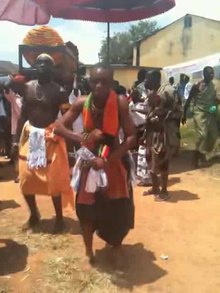
Traditional Adowa dance form and music performance.
The music of Ghana is diverse and varies between different ethnic groups and regions. Ghanaian music incorporates several distinct types of musical instruments such as the talking drum ensembles, Akan Drum, goje fiddle and koloko lute, court music, including the Akan Seperewa, the Akan atumpan, the Ga kpanlogo styles, and log xylophones used in asonko music.[230] The most well known genres to have come from Ghana are African jazz, which was created by Ghanaian artist Kofi Ghanaba,[231] and its earliest form of secular music, called highlife.[230] Highlife originated in the late 19th century and early 20th century and spread throughout West Africa.[230] In the 1990s a new genre of music was created by the youth incorporating the influences of highlife, Afro-reggae, dancehall and hiphop.[230] This hybrid was called hiplife.[230] Ghanaian artists such as “Afro Roots” singer, activist and songwriter Rocky Dawuni, R&B and soul singer Rhian Benson and Sarkodie have had international success.[232][233] In December 2015, Rocky Dawuni became the first Ghanaian musician to be nominated for a Grammy award in the Grammy Award for Best Reggae Album category for his 6th studio album titled Branches of The Same Tree[234] released 31 March 2015.
Ghanaian dance is as diverse as its music, and there are traditional dances and different dances for different occasions.[235] The most known Ghanaian dances are those for celebrations. These dances include the Adowa, Kpanlogo, Azonto, Klama, Agbadza, Borborbor and Bamaya.[235]
Film[edit]
Ghana has a budding and thriving film industry. Ghana’s film industry dates as far back as 1948 when the Gold Coast Film Unit was set up in the Information Services Department.[236] Some internationally recognised films have come from Ghana. In 1970, I Told You So was one of the first Ghanaian films to receive international acknowledgement and received great reviews from The New York Times.[237] It was followed by the 1973 Ghanaian and Italian production The African Deal also known as “Contratto carnale” featuring Bahamian American actor Calvin Lockhart.[238] 1983’s Kukurantumi: the Road to Accra, a Ghanaian and German production directed by King Ampaw, was written about by famous American film critic Vincent Canby.[239] In 1987, Cobra Verde, another Ghanaian and German production directed by Werner Herzog, received international acclamation and in 1988, Heritage Africa won more than 12 film awards.
In recent times there have been collaborations between Ghanaian and Nigerian crew and cast and a number of productions turned out. Many Ghanaian films are co-produced with Nollywood, the Nigerian film industry, and some are distributed by Nigerian marketers. Also, Nigerian filmmakers often feature Ghanaian actors and actresses in their movies and Ghanaian filmmakers feature Nigerian actors and actresses in theirs. Nadia Buari, Yvonne Nelson, Lydia Forson and Jackie Appiah all popular Ghanaian actresses and Van Vicker and Majid Michel both popular Ghanaian actors, have starred in many Nigerian movies. As a result of these collaborations, Western viewers often confuse Ghanaian movies with Nollywood and count their sales as one; however, they are two independent industries that sometimes share Nollywood. In 2009, Unesco described Nollywood as the second-biggest film industry in the world after Bollywood.[240]
Media[edit]
Ghana mass media, news and information provided by television.
The media of Ghana are amongst the most free in Africa. Chapter 12 of the 1992 Constitution of Ghana guarantees freedom of the press and independence of the media, while Chapter 2 prohibits censorship.[241] Post-independence, the government and media often had a tense relationship, with private outlets closed during the military governments and strict media laws that prevented criticism of government.[242]
Press freedoms were restored in 1992, and after the election in 2000 of John Agyekum Kufuor the tensions between the private media and government decreased. Kufuor supported press freedom and repealed a libel law, but maintained that the media had to act responsibly.[243] The Ghanaian media has been described as “one of the most unfettered” in Africa, operating with little restriction. The private press often carries criticism of government policy.[244]
Sports[edit]
Black Stars, the Ghana national football team.
Association football (or soccer) is the top spectator sport in Ghana and the national men’s football team is known as the Black Stars, with the under-20 team known as the Black Satellites.[245] Ghana has won the African Cup of Nations four times, the FIFA U-20 World Cup once, and has participated in three consecutive FIFA World Cups in 2006, 2010, and 2014.[245] In the 2010 FIFA World Cup, Ghana became the third African country to reach the quarter-final stage of the World Cup after Cameroon in 1990 and Senegal in 2002.[246] Ghana national U-20 football team, known as the Black Satellites, is considered to be the feeder team for the Ghana national football team. Ghana is the first and only country on the Africa continent to be crowned FIFA U-20 World Cup Champions,[245] and two-time runners up in 1993 and 2001. The Ghana national U-17 football team known as the Black Starlets are two-time FIFA U-17 World Cup champions in 1991 and 1995, two-time runners up in 1993 and 1997.[247]
Black Stars goal celebration.
Ghanaian football teams Asante Kotoko SC and Accra Hearts of Oak SC are the 5th and 9th best football teams on the Africa continent and have won a total of five Africa continental association football and Confederation of African Football trophies; Ghanaian football club Asante Kotoko SC has been crowned two-time CAF Champions League winners in 1970, 1983 and five-time CAF Champions League runners up, and Ghanaian football club Accra Hearts of Oak SC has been crowned 2000 CAF Champions League winner and two-time CAF Champions League runners up, 2001 CAF Super Cup champions and 2004 CAF Confederation Cup champions.[248] The International Federation of Football History and Statistics crowned Asante Kotoko SC as the African club of the 20th century.[248] There are several club football teams in Ghana that play in the Ghana Premier League and Division One League, both administered by the Ghana Football Association.[249]
Ghanaian winter sports Olympic team at the opening ceremony of the 2010 Winter Olympics
Ghana competed in the Winter Olympics in 2010 for the first time. Ghana qualified for the 2010 Winter Olympics, scoring 137.5 International Ski Federation points, within the qualifying range of 120–140 points.[250] Ghanaian skier, Kwame Nkrumah-Acheampong, nicknamed “The snow leopard“, became the first Ghanaian to take part in the Winter Olympics, at the 2010 Winter Olympics held in Vancouver, British Columbia, Canada,[251] taking part in the slalom skiing.[252]
Ghana finished 47th out of 102 participating nations, of whom 54 finished in the Alpine skiing slalom.[253][254] Kwame Nkrumah-Acheampong broke on the international skiing circuit, being the second black African skier to do so.[255]
Ghanaian athletes have won a total of four Olympics medals in thirteen appearances at the Summer Olympics, three in boxing, and a bronze medal in association football, and thus became the first country on the Africa continent to win a medal at association football.[256]
The country has also produced a number of world class boxers, including Azumah Nelson a three-time world champion and considered as Africa’s greatest boxer,[257][258] Nana Yaw Konadu also a three-time world champion,[258] Ike Quartey,[258] and Joshua Clottey.[258]
Ghana’s women’s football team won bronze at the Africa Women Cup of Nations 2016 edition in Yaoundé, Cameroon. The team beat South Africa 1–0.[259]
Ghana will host the 2023 African Games in Accra.
Cultural heritage and architecture[edit]
Ghanaian postmodern architecture
There are two types of Ghanaian traditional construction: the series of adjacent buildings in an enclosure around a common are common and the traditional round huts with grass roof.[260] The round huts with grass roof architecture are situated in the northern regions of Ghana (Northern, Upper East and Upper West regions), while the series of adjacent buildings are in the southern regions of Ghana (Ashanti, Brong-Ahafo, Central, Eastern, Greater Accra and Western regions).[260]
Ghanaian postmodern architecture and high-tech architecture buildings are predominant in the Ghanaian southern regions, while the Ghanaian heritage sites are most evident by the more than thirty forts and castles built in Ghana. Some of these forts are Fort William and Fort Amsterdam. Ghana has museums that are situated inside castles, and two are situated inside a fort.[261] The Military Museum and the National Museum organise temporary exhibitions.[261]
Ghana has museums that show a in-depth look at specific Ghanaian regions, there are a number of museums that provide insight into the traditions and history of their own geographical area in Ghana.[261] The Cape Coast Castle Museum and St. Georges Castle (Elmina Castle) Museum offer guided tours. The Museum of Science and Technology provides its visitors with a look into the domain of Ghanaian scientific development, through exhibits of objects of scientific and technological interest.[261]
National symbols[edit]
The tawny eagle appears on the coat of arms of Ghana.
The coat of arms depicts two animals: the tawny eagle (Aquila rapax, a very large bird that lives in the savannas and deserts;[262] 35% of Ghana’s landmass is desert, 35% is forest, 30% is savanna) and the lion (Panthera leo, a big cat); a ceremonial sword, a heraldic castle on a heraldic sea, a cocoa tree and a mine shaft representing the industrial mineral wealth of Ghana, and a five-pointed black star rimmed with gold representing the mineral gold wealth of Ghana and the lodestar of the Ghanaian people.[263] It also has the legend Freedom and Justice.[263]
The flag of Ghana consists of three horizontal bands (strips) of red (top), gold (middle) and green (bottom); the three bands are the same height and width; the middle band bears a five-pointed black star in the centre of the gold band, the colour red band stands for the blood spilled to achieve the nation’s independence: gold stands for Ghana’s industrial mineral wealth, and the color green symbolises the rich tropical rainforests and natural resources of Ghana.[45][263]
Tourism[edit]
In 2011, 1,087,000 tourists visited Ghana.[265] Tourist arrivals to Ghana include South Americans, Asians, Europeans, and North Americans.[266] The attractions and major tourist destinations of Ghana include a warm, tropical climate year-round, diverse wildlife, waterfalls such as Kintampo waterfalls and the largest waterfall in west Africa, Wli waterfalls, Ghana’s coastal palm-lined sandy beaches, caves, mountains, rivers, and reservoirs and lakes such as Lake Bosumtwi and the largest man-made lake in the world by surface area, Lake Volta, dozens of forts and castles, World Heritage Sites, nature reserves and national parks.[266]
The World Economic Forum statistics in 2010 showed that out of the world’s favourite tourist destinations, Ghana was ranked 108th out of 139 countries.[267] The country had moved two places up from the 2009 rankings. In 2011, Forbes magazine, published that Ghana was ranked the eleventh most friendly country in the world. The assertion was based on a survey in 2010 of a cross-section of travellers. Of all the African countries that were included in the survey, Ghana ranked highest.[267] Tourism is the fourth highest earner of foreign exchange for the country.[267] In 2017, Ghana ranks as the 43rd–most peaceful country in the world.[268]
To enter Ghana, it is necessary to have a visa authorised by the Government of Ghana. Travelers must apply for this visa at a Ghanaian embassy; this process can take approximately two weeks. By law, visitors entering Ghana must be able to produce a yellow fever vaccination certificate.[269]
According to Destination Pride[270] – a data-driven search platform used to visualize the world’s LGBTQ+ laws, rights and social sentiment – Ghana’s Pride score is 22 (out of 100).[271]
Panorama view of Kakum National Park, located in the coastal environs of the Central region on the Gulf of Guinea and Atlantic Ocean, covers an area of 375 square kilometres (145 sq mi). Established in 1931 as a game reserve and nature reserve, it was gazetted as a national park only in 1992 after an initial survey of avifauna was conducted. The national park is covered with tropical rainforest.[272][273][274] Kakum National Park is the only national park in Africa with a canopy walkway, which is 350 metres (1,150 ft) long and connects seven canopy tree tops which provides access to the rainforests.[273][275]






